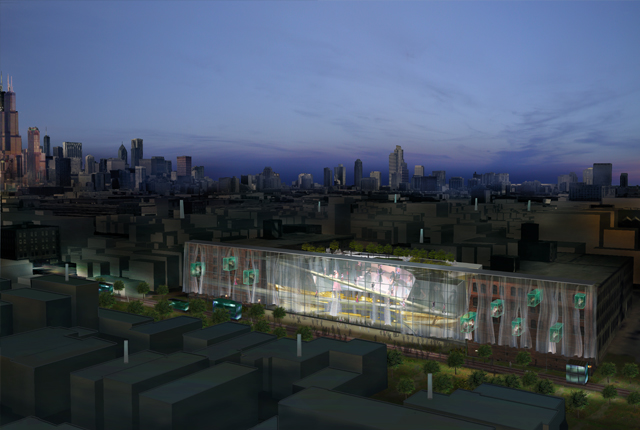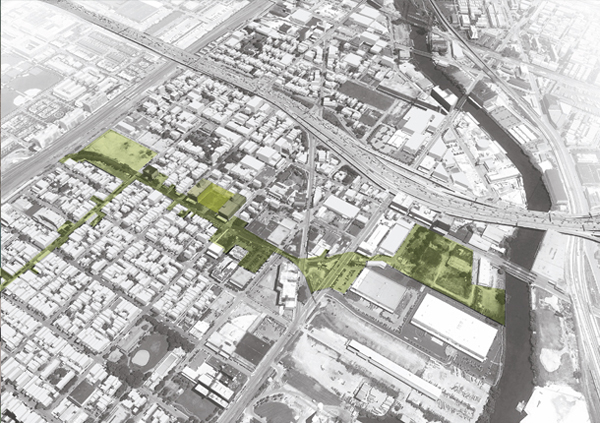Architect’s Pilsen vision is green and fashion friendly
By Robin Amer

Architect’s Pilsen vision is green and fashion friendly
By Robin Amer
Architect Patricia Saldaña Natke grew up on the 4800 block of South Marshfield Avenue, in Chicago’s Back of the Yards neighborhood. Her parents, immigrants from Mexico, worked in the Stockyards.
Some days after school, Saldaña Natke would take the bus away from her aging, blue collar neighborhood with its bungalows and smoke stacks, up to the Loop, and marvel at the sparkling skyscrapers and expansive public parks in the city’s downtown.
“I would look at the beautiful buildings and wonder why those kinds of spaces weren’t in existence where I lived,” Saldaña Natke recalled. “That’s the reason I became an architect; I felt that public places should be the greatest in the area of most need.”
Saldaña Natke channeled those beliefs into UrbanWorks, the architecture and planning firm she founded, which specializes in socially and environmentally conscious planning and design work — the kind she dreamed about as a kid. She’s set her sights on one Chicago hood in particular: Pilsen.
“[Pilsen] needs to be a place where people can move upward in mobility,” Saldaña Natke said. “The entire core of why I work in Pilsen comes to the fact that there are neighborhoods that need a lot of attention.”
UrbanWorks’ previous Pilsen projects include a college dormitory intended to help keep students from the neighborhood on the path to academic success, a high school designed to resemble the copper canyons of Mexico and Saldaña Natke’s most ambitious project: a master plan for Pilsen.
In architecture and planning circles, a master plan is a grand vision for the future development of a neighborhood.
“It’s much more than a wish list,” Saldaña Natke said. “It may be implemented slightly different than the plan shows, but the core of it should remain intact.”

Saldaña Natke consulted with Pilsen residents in a series of community meetings, including a neighborhood-wide meeting at Providence of God Catholic Church in 2004. The resulting plan aims to build on Pilsen’s assets: its strong Mexican cultural heritage, its main commercial drag zoned for pedestrian use and its historic architecture.
“The community says church steeples are its high rises,” Saldaña Natke said.
The plan calls for greater access to the Chicago River and also addresses what Saldaña Natke says are the neighborhood’s challenges: While the west side of Pilsen is served by the CTA’s Pink, Green and Orange Lines, the east side has few transportation options, leaving the neighborhood disconnected.
And, there is a surprising lack of green space in Pilsen. According to Saldaña Natke, the city requires two acres of green space for every 1,000 Chicago residents.
“But the Park District just said to us that the recommended amount is four acres of green space,” she said. “[Pilsen] is over 18 acres short.”
So, UrbanWorks’ master plan starts there. Saldaña Natke envisions more green space along the neighborhood’s largely industrial waterfront, and the transformation of an abandoned, surface-level railway that runs along Sangamon Street into a stretch of park—something like New York’s High Line or the Northwest Side’s Bloomingdale Trail, only without the elevation. Then, she hopes to transform the abandoned buildings that line the railroad into a fashion and textile incubator.
A fashion incubator?
Yes, Saldaña Natke says.
“You shouldn’t need to go to 900 North Michigan or Michigan Avenue to see all the high-end fashion shows. Why can’t it be in the neighborhoods?”
You can hear Saldaña Natke describe her dream in more detail in the audio above.
Dynamic Range showcases hidden gems unearthed from Chicago Amplified’s vast archive of public events and appears on weekends. Patricia Saldana Natke spoke at an event presented by the Chicago Architecture Foundation in April of 2013. Click here to hear the event in its entirety.
Robin Amer is a producer on WBEZ’s digital team. Follow her on Twitter @rsamer.
